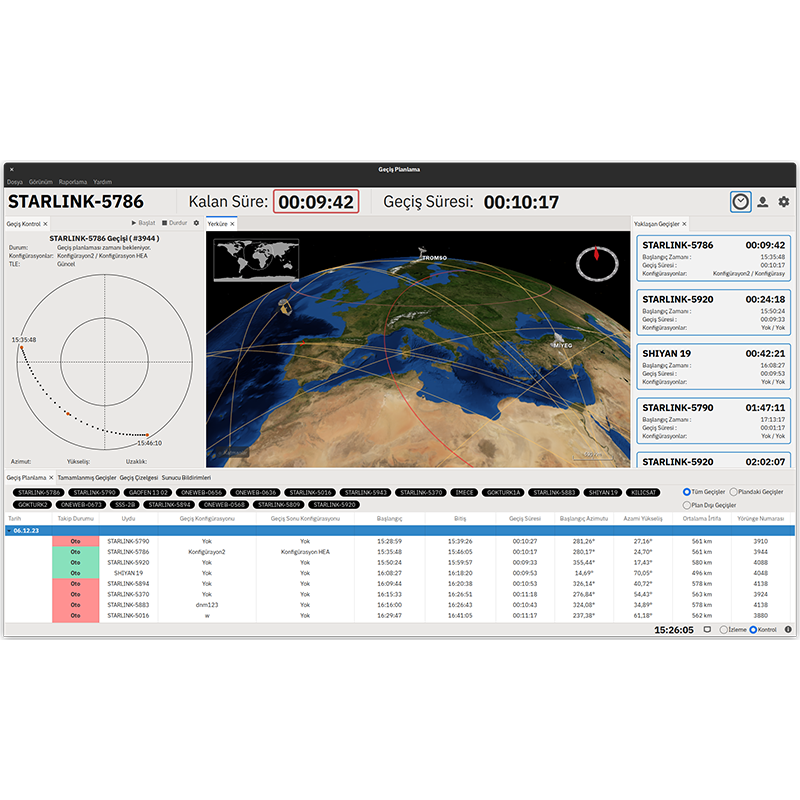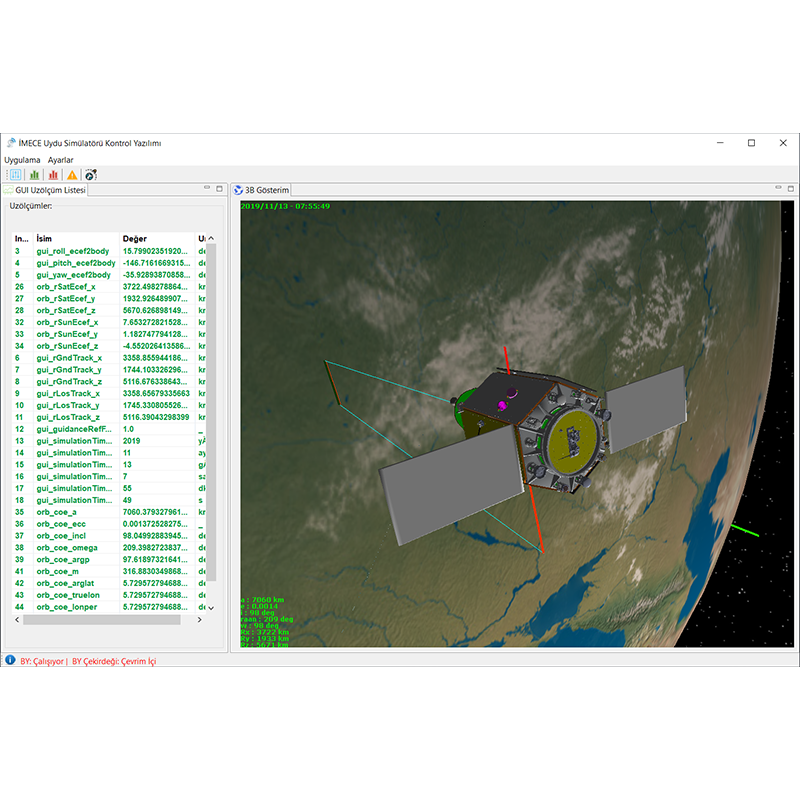UZAY
Ground Station
The Ground Station is designed to communicate with satellites in low Earth orbit (LEO) and performs several critical functions:
- Data Reception and Transmission: It receives data from LEO satellites and transmits data to them. This data includes health monitoring information, mission data, and captured images.
- Tracking and Control: It monitors the position and orbit of the satellites, checks the health status of the satellites, and makes corrective maneuvers if necessary. This ensures that satellites remain in the correct orbit and successfully complete their missions.
- Telemetry and Command: It conducts telemetry and command operations, monitoring the status of satellite systems and sending commands when needed. This function is crucial for maintaining the operation and safety of the satellites.
- Data Processing and Storage: It processes and stores raw data received from the satellites. Processed data can then be transmitted to local or remote data centers for further analysis and various applications.
- Timing and Synchronization: It ensures that satellites are synchronized with specific points on Earth to capture images. This feature is critically important for observation satellites.
- Recovery and Reconfiguration: It manages recovery operations if the connection with a satellite is lost or in case of a malfunction, and performs reconfiguration tasks to restore the functionality of the satellite when needed.
The ground station is vital for the success of satellite operations and is used for operating the satellites developed within our Institute.
Ground Station Control Software
(Global Positioning System Low Noise Amplifier)
S-Band and X-Band Ground Station control is carried out, satellite transits are planned and executed, and communication infrastructure is provided over baseband units with the satellite during transits.
- Monitoring and control of the devices at the ground station
- Calculating transits with TLE information of satellites
- Planning and execution of automatic or manual transitions
- Antenna guidance and control of communication equipment during the transition
- Ensuring satellite communication with Mission Control Software

Control Software Features
Key Features
- Calculation of future transits for ground station from satellite TLE data
- Conflict analysis of transitions, automatic or manual transition plan
- Determination of transition start and end configurations
- Calculation of antenna orientation data for program tracking in transit and steering during transit
- Control of ground station devices through their own interfaces
- Defining command and measurement data of devices in a common structure
- Sending commands to devices from a common interface
- Monitoring the measurement data from the devices with tables and graphs
- Remote Earth Station identification and calculation of transits
Installation / Configuration
Server-client architecture, multi-client usage
Use with Linux operating system
Adding and removing ground station devices with different interfaces
Task-oriented customization with microservice architecture
5.4 m Diameter Ground Station Antenna
(Global Positioning System Low Noise Amplifier)
- It is a fully mobile antenna capable of tracking and communicating with low-altitude satellites.
- It supports S-Band up and down communication and X-Band down communication.
- It has a 3-degree elevation angle with X/Y type movement system with no key hole that cannot be followed.

Ground Station Antenna Specifications
Key Features
- Operating Temperature Range: -20°C to 50°C
- Output power (dBW): 20
- G/T (dB/K):
S-Band: 16dB/K
X-Band: 28 dB/K - TX Frequency Range (MHz): 2025-2120
- Uplink Modulation Type: CPFSK - BPSK
- Uplink Data Rate (bps): 9.600
- RX Frequency Range (MHz):
S-Band:2200-2290
X-Band:8000-8400 - Downlink Modulation Type: BPSK - QPSK
- Downlink Data Rate (bps):
S-Band:2,000,000
X-Band:100,000,000 - Satellite Tracking System (yes/no): Yes
- Antenna Type: Cassegrain - Parabolic Reflector
- Antenna diameter (m): 5,4
- Polarization:
S-Band: RHCP/LHCP
X-Band: RHCP - Antenna Gain (dBi / dBiC):
S-Band: 38 dBi
X-Band: 50.5 dBi
Antenna beamwidth (degrees):
S-Band: 1.83
X-Band: 0.53 - Orientation Capability (Rotor System)(yes/no): Yes
- Rotational range:
Azimuth (degrees): 0-360
Elevation (degrees): 0-90 - Pointing accuracy (degrees): 0,1
- Rotational speed (degrees/second): 4
7.3 m Diameter Ground Station Antenna
(Global Positioning System Low Noise Amplifier)
- It is a fully mobile antenna capable of tracking and communicating with low-altitude satellites.
- It supports S-Band up and down communication and X-Band down communication.
- It has a 3-degree elevation angle with X/Y type movement system with no key hole that cannot be followed.
- It has an automatic tracking feature that can capture the best signal angle.

Ground Station Antenna Specifications
Key Features
- Operating Temperature Range : -10 to +50
- Output Power (dBW): 20
G/T (dB/K):
X-Band: 31.7,
S-Band: 19.98 - TX Frequency Range (MHz): 2000-2200
- Uplink Modulation Type: CPFSK, BPSK, GMSK
- Uplink Data Rate (bps): 0-100,000
- RX Frequency Range (MHz): 2200-2400, 8000-8400
- Downlink Modulation Type: BPSK,QPSK,OQPSK,n-PSK
- Downlink Data Rate (bps): 10 Mbps-1,000 Mbps
- Satellite Tracking System (yes/no): Yes
- Antenna Type: Cassegrain
- Antenna Diameter (m): 7,3
- Polarization RHCP,LHCP
- Antenna Gain (dBi / dBiC):
54.1 dBi (at 8-8.4 GHz X-Band frequencies)
43.4 dBi (at 2-2.4 GHz S-Band frequencies) - Antenna beamwidth (degrees):
0.34 (at 8-8.4 GHz X-Band frequencies)
1.3 (at 2-2.4 GHz S-Band frequencies) - Orientation Capability (Rotor System)(yes/no): Yes
- Rotational range:
Azimuth (degrees): 0-360
Elevation (degrees): 0-90 - Pointing accuracy (degrees): 0,05
- Rotational speed (degrees/second): 5

